Top Rankings
Sangamon Valley CUSD 9 School District ranks among the top 20% of public school district in Illinois for:
Category
Attribute
Student Attention
Lowest student:teacher ratio (Top 1%)
For the 2025 school year, there are 4 public schools serving 616 students in Sangamon Valley CUSD 9 School District. This district's average testing ranking is 3/10, which is in the bottom 50% of public schools in Illinois.
Public Schools in Sangamon Valley CUSD 9 School District have an average math proficiency score of 11% (versus the Illinois public school average of 26%), and reading proficiency score of 26% (versus the 30% statewide average).
Minority enrollment is 8% of the student body (majority Hispanic and Black), which is less than the Illinois public school average of 56% (majority Hispanic).
Overview
This School District
This State (IL)
# Schools
4 Schools
4,399 Schools
# Students
616 Students
1,881,773 Students
# Teachers
54 Teachers
136,664 Teachers
Student : Teacher Ratio
11:1
11:1
District Rank
Sangamon Valley CUSD 9 School District, which is ranked within the bottom 50% of all 844 school districts in Illinois (based off of combined math and reading proficiency testing data) for the 2020-2021 school year.
The school district's graduation rate of 85-89% has increased from 75-79% over five school years.
Overall District Rank
#679 out of 852 school districts
(Bottom 50%)
(Bottom 50%)
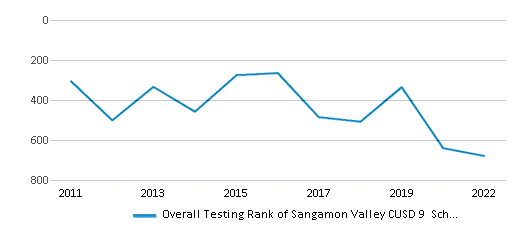
Math Test Scores (% Proficient)
(20-21)10%
28%
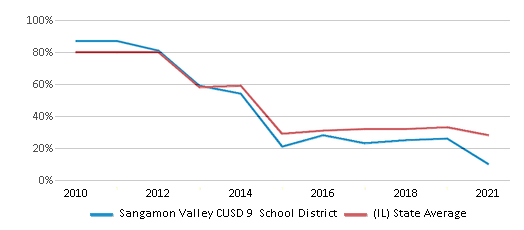
Reading/Language Arts Test Scores (% Proficient)
24%
30%
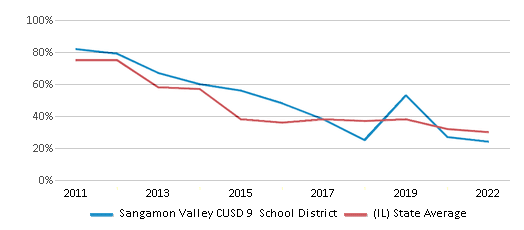
Science Test Scores (% Proficient)
55-59%
50%
Graduation Rate
85-89%
87%
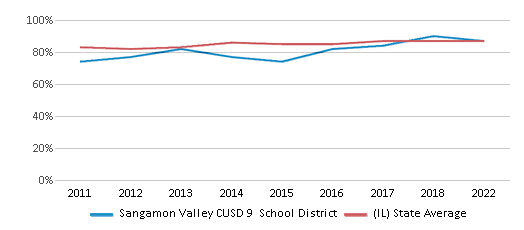
Students by Ethnicity:
Diversity Score
0.15
0.70
# American Indian Students
4 Students
4,556 Students
% American Indian Students
1%
1%
# Asian Students
4 Students
103,630 Students
% Asian Students
1%
6%
# Hispanic Students
15 Students
517,685 Students
% Hispanic Students
2%
28%
# Black Students
8 Students
303,129 Students
% Black Students
1%
16%
# White Students
567 Students
837,178 Students
% White Students
92%
45%
# Hawaiian Students
n/a
1,684 Students
% Hawaiian Students
n/a
n/a
# Two or more races Students
18 Students
78,057 Students
% of Two or more races Students
3%
4%
Students by Grade:
# Students in PK Grade:
57
79,660
# Students in K Grade:
32
120,716
# Students in 1st Grade:
40
126,380
# Students in 2nd Grade:
30
167,371
# Students in 3rd Grade:
35
130,316
# Students in 4th Grade:
36
130,337
# Students in 5th Grade:
56
129,914
# Students in 6th Grade:
40
132,189
# Students in 7th Grade:
40
135,696
# Students in 8th Grade:
56
137,626
# Students in 9th Grade:
62
149,483
# Students in 10th Grade:
42
150,499
# Students in 11th Grade:
44
146,819
# Students in 12th Grade:
46
144,755
# Ungraded Students:
-
12
District Revenue and Spending
The revenue/student of $20,791 in this school district is less than the state median of $21,990. The school district revenue/student has grown by 6% over four school years.
The school district's spending/student of $29,523 is higher than the state median of $21,244. The school district spending/student has grown by 6% over four school years.
Total Revenue
$13 MM
$41,381 MM
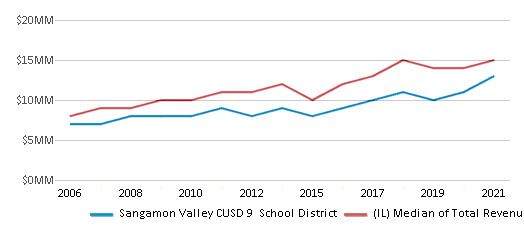
Spending
$18 MM
$39,976 MM

Revenue / Student
$20,791
$21,990
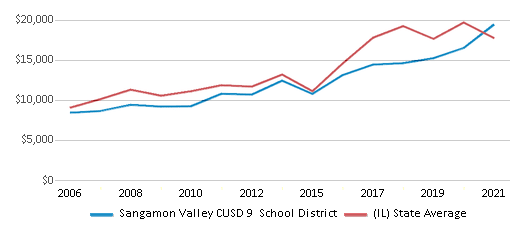
Spending / Student
$29,523
$21,244
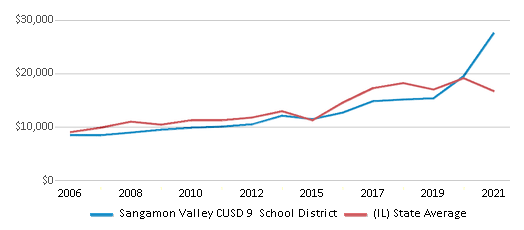
Best Sangamon Valley CUSD 9 School District Public Schools (2025)
School
(Math and Reading Proficiency)
(Math and Reading Proficiency)
Location
Grades
Students
Rank: #11.
Sangamon Valley Intermediate School
Rank:
6/
Top 50%10
341 Matilda St
Illiopolis, IL 62539
(217) 486-7521
Illiopolis, IL 62539
(217) 486-7521
Grades: 3-5
| 127 students
Rank: #22.
Sangamon Valley Primary School
(Math: 15-19% | Reading: 45-49% )
Rank:
Rank:
6/
Top 50%10
1095 N Meridian
Harristown, IL 62537
(217) 963-2621
Harristown, IL 62537
(217) 963-2621
Grades: PK-2
| 159 students
Rank: #33.
Sangamon Valley Middle School
Rank:
3/
Bottom 50%10
341 Matilda St
Illiopolis, IL 62539
(217) 486-2241
Illiopolis, IL 62539
(217) 486-2241
Grades: 6-8
| 136 students
Rank: #44.
Sangamon Valley High School
Rank:
2/
Bottom 50%10
398 N Illinois St
Niantic, IL 62551
(217) 668-2392
Niantic, IL 62551
(217) 668-2392
Grades: 9-12
| 194 students
Frequently Asked Questions
How many schools belong to Sangamon Valley CUSD 9 School District?
Sangamon Valley CUSD 9 School District manages 4 public schools serving 616 students.
What is the rank of Sangamon Valley CUSD 9 School District?
Sangamon Valley CUSD 9 School District is ranked #630 out of 844 school districts in Illinois (bottom 50%) based off of combined math and reading proficiency testing data for the 2020-2021 school year. This district ranks in the top 20% of Illinois school districts for: Lowest student:teacher ratio (Top 1%)
What is the racial composition of students in Sangamon Valley CUSD 9 School District?
92% of Sangamon Valley CUSD 9 School District students are White, 3% of students are Two or more races, 2% of students are Hispanic, 1% of students are American Indian, 1% of students are Asian, and 1% of students are Black.
What is the student/teacher ratio of Sangamon Valley CUSD 9 School District?
Sangamon Valley CUSD 9 School District has a student/teacher ratio of 11:1, which is lower than the Illinois state average of 14:1.
What is Sangamon Valley CUSD 9 School District's spending/student ratio?
The school district's spending/student of $29,523 is higher than the state median of $21,244. The school district spending/student has grown by 6% over four school years.
Recent Articles

Year-Round Or Traditional Schedule?
Which is more appropriate for your child? A year-round attendance schedule or traditional schedule? We look at the pros and cons.

Why You Should Encourage Your Child to Join a Sports Team
Participating in team sports has a great many benefits for children, there is no doubt. In this article you will learn what those benefits are.

White Students are Now the Minority in U.S. Public Schools
Increasing birth rates among immigrant families from Asia and Central and South America, combined with lower birth rates among white families, means that for the first time in history, public school students in the United States are majority-minority. This shift in demographics poses difficulties for schools as they work to accommodate children of varying language abilities and socio-economic backgrounds.





